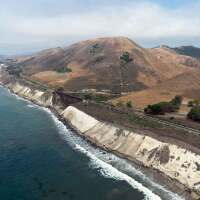Hollister Ranch: A Brief Look at Four Decades of Legal History
The key to understanding an historic battle over a stretch of the California coast is: development permits. To understand why the people of California once might have had access to the coast at Hollister Ranch; to understand why the state almost chose to give that right up; to understand how the Coastal Commission might finally achieve access at Hollister Ranch after more than 40 years of fighting; it’s important to understand development permits. Bear with me. It’s like “Chinatown” — you have to spend some time in the Hall of Records before you get to the shocking twist.
There are two threads to follow here: one’s about an Offer to Dedicate (OTD) and one’s about an in-lieu fee. An OTD is a document signed by a private property owner granting rights of public access to the State. In the 1970s, before Hollister Ranch was subdivided, the Los Angeles YMCA owned a piece of land there. In 1979 they applied for a permit to build a camp for kids from Los Angeles. The Coastal Act gives the Coastal Commission the authority to require public access provisions in any new development in the coastal zone; and the Commission used this authority to make public access a condition of the permit. So the YMCA granted “to the People of California an easement in perpetuity for the purposes of public access and public recreational use” of its land at Cuarta Canyon Beach, which is part of the coast at the
Ranch. This OTD also gave the public the right to cross other YMCA-owned land on the surrounding Ranch land to get to the beach.
But by this time the rest of Hollister Ranch had been divided into 100-acre parcels and sold to private owners, who were not enthusiastic about sharing their beaches with campers and the general public. When the YMCA started building its camp, the Hollister Ranch Owners Association (HROA) sued to stop the construction.
The HROA and the YMCA settled, and as a result, the Hollister owners bought the YMCA’s land. But the OTD was already in place, and easements do not expire when the land they’re on is sold. In theory that means that the State still owns the right to establish a public access route to Cuarta Canyon. But the HROA has sued the state repeatedly, arguing that the YMCA never had the right to grant those easements in the first place. That’s the suit that would be settled by the recent agreement between the Commission and the HROA, if it is finalized in November.
Meanwhile the second thread developed: the in-lieu fees. As the Hollister owners sued to keep the public out, they also started to develop their land. Which meant they needed permits. So again, the Coastal Commission required that permits for Hollister land include plans for public access. And again, the owners sued.
They argued that no Hollister owner could grant access easements to the piece, since the beach parcels in Hollister Ranch were (and are) owned not by any individual owner but by a third party — the HROA, a corporation created when the Ranch was subdivided to manage the Ranch’s coastal lands cooperatively.
So the Legislature passed a law meant to cover situations like Hollister’s. Instead of granting individual easements, parcel owners would pay an “in-lieu fee” to fund the purchase of public access easements across the whole subdivision. The amount of the fee was to be set after state employees surveyed the relevant land to determine its value.
The money from the fees would have gone to support a comprehensive public access program put together by the Commission’s staff. A 1982 version of that plan envisioned bike, pedestrian, and shuttle bus access to multiple sites along the beach; special sites set aside for “scientific and educational study”; campsites; a public right to walk the whole length of the shoreline parallel to the Ranch; and regular monitoring “to assess the impact of public use on coastal resources at Hollister Ranch.”

But the owners argued that the new law didn’t apply to Hollister and refused to let Commission staff on their property to do the surveys. So in 1984 the Legislature passed another law that called out the Ranch by name:
It is the intent of the Legislature that the State Coastal Conservancy and the State Public Works Board utilize their authority provided under law to implement, as expeditiously as possible, the public access policies and provisions of this division at the Hollister Ranch in Santa Barbara County.
It’s fair to say that the 1984 law failed in its intent. It set the development fee at $5,000 and specified that the money would go to the Coastal Conservancy “for use in implementing the public access program.” But in the 34 years since the in-lieu fee program was put in place, Hollister owners have paid their fees, built their houses, and blocked all attempts at publicly managed access programs. In the meantime, they’ve argued that their existing privately-managed access program is enough public access under the Coastal Act, and that further access would threaten the Ranch’s supposedly pristine ecology.
So things stood for 34 years. But since the Settlement Agreement was announced this summer, a public outcry has pushed the Commission to take major new steps toward access. Commission staff recently announced that they’re working to update the Access Plan, and that they will no longer approve new permits for development at Hollister Ranch unless the owners agree to real public access. And other agencies have started to investigate what actions they could take to establish access at the Ranch. Even if the settlement agreement is finalized — even if the state gives up the OTD — the 40-year fight for Hollister Ranch is not over.


